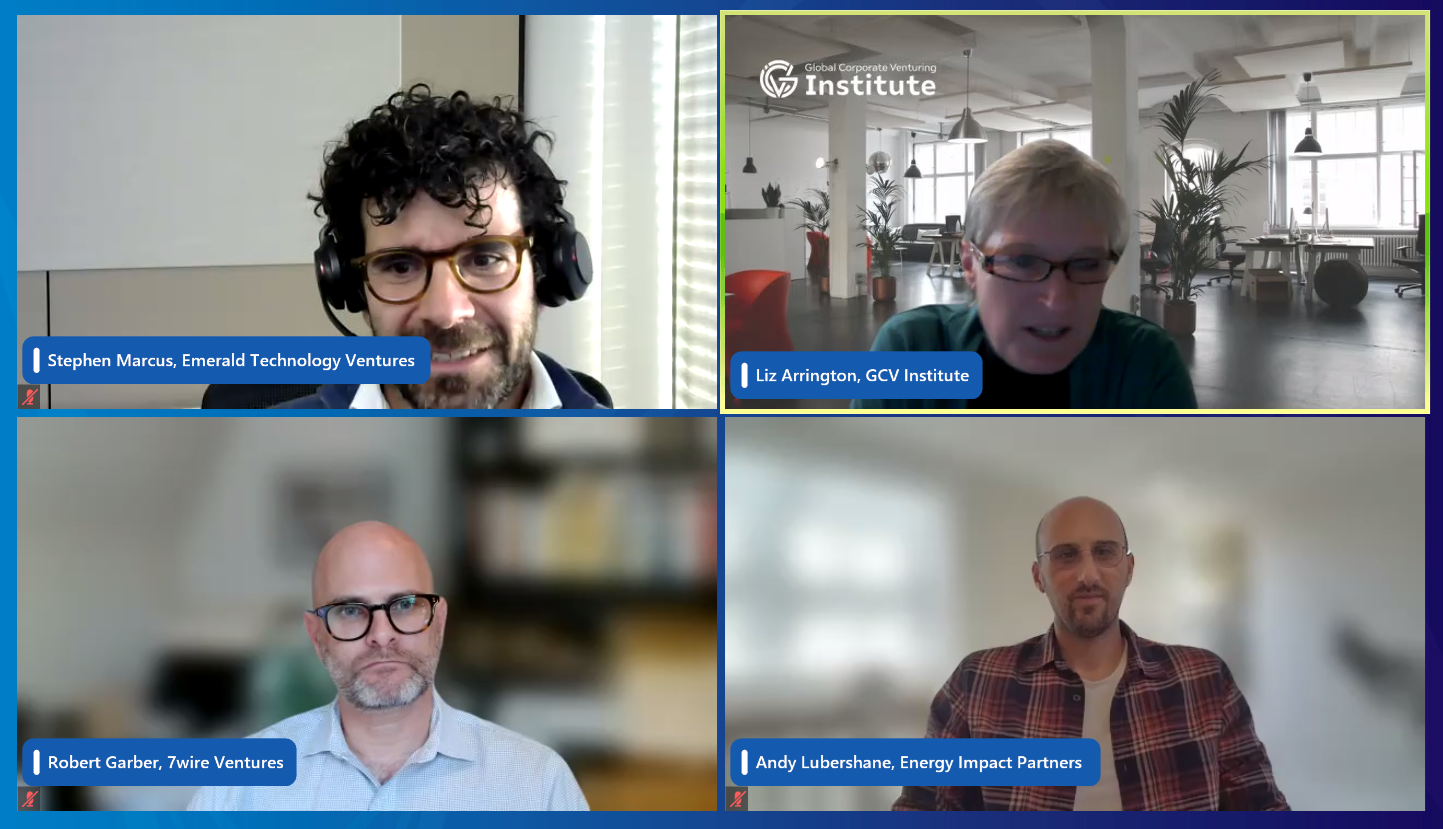Here’s how to make the relationship between a VC and its strategic corporate LPs one that benefits both sides.

Corporates that view investing in startups through an external VC fund as a passive, hands-off experience should think again.
A growing number of venture capital firms specialise in taking on corporations as strategic limited partner (LP) investors in their funds. And those VCs expect their corporate LPs to play an active role in engaging with the VC team, the portfolio companies and the other investors in the fund.
“The ideal LP is a really engaged LP. The whole point of working with corporate strategic LPs is that it’s not a purely passive investment,” says Andy Lubershane, partner at Energy Impact Partners, a venture capital firm focused on the energy sector which has some 70 energy companies contributing to the $4bn it has under management.
A growing number of corporations invest in external VC funds as part of their venturing strategy — nearly half of the companies in last year’s GCV Keystone annual survey indicated they do this. And older, more established CVC units are even more likely to do this (58%) than new ones (43%).
These more experienced corporates are exactly the partners that VCs like Energy Impact Partners seek, because they aren’t just looking for a source of capital but also for strategic collaborators.
“We want to be ideating with our partners. We want to be engaging in diligence with them. That’s the number one thing that we look for is if they want to be an active partner in sourcing and diligencing and building great companies with us,” says Lubershane.
In our recent The Next Wave webinar Strategic GP-LP relationships — creating the win-win, we spoke to Lubershane, as well as Robert Garber, managing partner of healthcare VC 7wireVentures, and Stephen Marcus of venture capital firm Emerald, about how they work with corporate investors in their funds. This is what we learned:

These VC-corporate partnerships are for industries in transition
Energy Impact Partners was set up in 2015 in response to a number of utility companies that were seeking ways to invest in the next generation of the power grid, and wanted to do this collectively.
“A lot of corporates in the oil and gas sector, in the building space, other industrials, have recognised that we need to be in the same room with the utilities who control the core infrastructure of the energy transition if we’re going to be investing in the energy transition. We need to work alongside them to define the next generation of technology,” says Lubershane.
In the healthcare sector, 7wireVentures was set up with similar goals. The Chicago-based firm is an early-stage venture investor and has between 15 and 20 corporate investors that are large healthcare industry stakeholders, including health insurers such as Blue Cross, Blue Shield, pharmaceuticals companies and large US healthcare systems.
Garber at 7wireVentures says the team wanted to include corporate investors in the fund because they knew it would not be possible to create real change in healthcare without collaborating with the incumbent stakeholders.
“We have to partner with these stakeholders, because they wield such tremendous power in our industry.”
Robert Garber, 7wire Ventures
“People love to use the word disintermediation in healthcare but we need doctors, we need drug companies, we need insurers. These ecosystems in healthcare are so entrenched that we have had to think about how to co-opt these partners to drive change,” says Garber.
“It’s been a very intentional sort of partnership in recognition that we have to partner with these stakeholders, because they wield such tremendous power in our industry.”
Emerald, a $1bn fund with offices in Switzerland and Canada, meanwhile, has 50 corporate LPs in its fund. Although it focuses on several different sectors, much like Energy Impact Partners and 7wireVentures, it works with companies in industries that are facing large, structural changes.
“Our LP base is diverse but the thing that brings them together is that they realise a lot of their industries are under transition or transformation,” says Marcus. “We look for corporates that are facing urgent challenges.”
Corporates demand a lot from these VCs
The relationship between VC firms and their strategic corporate investors can be complex as most are looking for much than financial returns.
That’s not to say that the financial performance of the investment portfolio is not important, says Marcus.
“They do want the financial return. They want to make sure we’re not torching their money,” he says. “But really, when they look back on the relationship after a long period of time, they want to understand what the strategic value is.”
On the most basic level, corporates are looking for insight and guidance on emerging markets and startups.
“Broadly speaking, our corporate LPs want exposure to new ideas,” says Lubershane. “They want insight into the emerging technology ecosystem. They want us to help them make sense of the noise, because there’s lots of startup companies out there. They look to us to do at least a first pass on what’s interesting and what’s not.”
“My grandmother would be proud of me because we’re trying to put people together and create romance between our portfolio and our LPs.”
Andy Lubershane, Energy Impact Partners
Further down the line they want the VC to help them connect with startups — either so they can invest in them directly, build technology partnerships with them, or even acquire them.
Marcus says that between 60% and 70% of the startup funding deals that it does will have an LP from the fund as a co-investor.

Lubershane, meanwhile, says that collaborations between portfolio companies and corporates is a key goal.
“We’re never pushing anything on them. They don’t have to work with any of our portfolio companies. But part of the reason they sign up is because they want to find companies that they can partner with,” he says. “My grandmother would be proud of me because we’re trying to put people together and create romance between our portfolio and our LPs.”
Corporate-focused VCs provide high levels of contact
A VC with corporate investors must work fairly hard in return for the capital. Energy Impact Partners, 7wireVentures and Emerald all provide a number of personalised services for their investors. Energy Impact Partners’ 20-person team spends time collaborating with its corporate LPs on market research and intelligence.
“A lot of that takes the form of doing collaborative working groups where we get folks together for day long sessions focused on specific subtopics, to hear pitches from companies in that space and brainstorm ideas,” says Lubershane. Results from these sessions get packaged up as reports that are distributed to investors.
Even with a much smaller team, 7wireVentures does something similar.
“We’re together twice a quarter with all of our corporate LPs, trying to provide a view into market dynamics, pipeline, portfolio activity,” he says. In addition to brainstorming, these sessions are often about creating connections between different strategic LPs.
There are also strategic one-to-one sessions twice a year with strategic investors and their C-suites to talk over strategy.
Emerald goes even further. It runs a secondment programme where investment professionals from corporate LPs can come and work alongside the Emerald team for a period of time, usually between four weeks and six months, to learn more about VC investing.

“It’s usually somebody that already has some level of experience, manager level people. We run a series of workshops for them to take them through our VC practice, how we source deals, how we assess them, how we evaluate them, how we manage our portfolio, how we take them right through to exit,” says Marcus. Sometimes it is a prelude to the corporate setting up its own direct investment operations.
Emerald has also created an online portal as a resource for its LPs. Details of every deal the team looks at, regardless of whether they pursue it or not, is entered into the system, so that LPs can use it as a reference in deals they might be considering or for understanding the range of companies in a certain investment area.
But the VCs demand a lot from corporates, too
The starting point for one of these corporate-VC relationships is an urgent need for change. The second thing Garber says he looks for is whether the corporation has the intention of sticking with the VC fund for the long term. “Making sure that you fund it properly and think about it as a multi-year funding exercise,” he says.
Because it takes a long time for a VC fund strategy to produce results, says Marcus, there is little point in pursuing an engagement with a company that may pull out after only a few years.
“We really look for the ones that have the intention to stay with this for at least eight to 10 years, because it’s going to be a while until you will really be able to show success and big results within your organisation,” he says.
“You really want that person to not ‘just’ be a CVC. The best counterparts are people that have experience in the operating businesses.”
Andy Lubershane, Energy Impact Partners
There also needs to be at least one person who is specifically assigned to manage the relationship with the VC.
“It doesn’t mean anything unless you’ve actually stuck a person with the responsibility of engaging. It doesn’t have to be their full-time job, but you need someone who’s going to be that point of contact between the corporate and whatever activity is going on in the venture side,” says Lubershane.
The best point person, by the way, is not necessarily someone in the corporate venture team.
“What we found over time is you really want that person to not ‘just’ be a CVC. You want them to have really good connectivity into the core business. We found that the best counterparts are people that have experience in the operating businesses and they have relationships in the operating businesses,” Lubershane says.
“We very much prefer someone who has a real history with the company, and ideally, a history with the operating business. You want someone who has relationships outside of the corporate venture team, or outside of the small innovation team.”
Sometimes a mix of people to deal with from the company could be the best option, says Garber.
“The best situation is when you have people both from the operating units and from the CVC group. Typically, we’ll see a CVC person, head of innovation, or chief strategy officer, but also senior managers within the operating units that will be able to help drive the downstream collaboration.”
There was much more discussed in detail in the full webinar session. You can watch the full replay here:
This webinar is part of GCV’s The Next Wave series of webinars. We run a webinar on the second Wednesday of every month, alternating between advice for CVC practitioners and deep dives into specific investment areas. Our next webinar will be: Pop, beauty and chips: How to invest in South Korea. Register here to secure your place.

